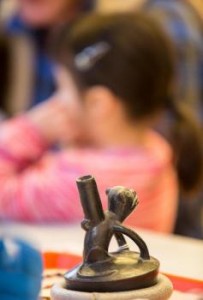For four years, the Burke Museum of Natural History worked with the Peruvian government to identify objects such as human remains, ceramic vessels and bowls, a collection of dolls, necklaces, and textiles. On November 5, the Peruvian Consul General attended a gathering for the final exhibition of the items; and the following week, the items were packed up and transported to Peru. Those items were identified for repatriation under a UNESCO Convention on the Means of Prohibiting and Preventing the Illicit Import, Export, and Transfer of Ownership of Cultural Property. The convention permits government to designate meaningful objects of cultural heritage and protect them from leaving the country from which they originated. This repatriation shows that the museum is fulfilling the ethical responsibilities that come with having excavated artifacts. The UNESCO convention supports the idea that the identity of people is linked to the past, which people learn about from artifacts. Thus, the countries that use the UNESCO convention to repatriate artifacts can reclaim information from their past.

Figure 1- A ceramic vessel collected from Mochica, Peru, is one of the objects returned to the Peruvian government.
Dr. Peter Lape, associate director of research and curator of archaeology at the Burke Museum, said, “We are glad to help send these collections to Peru.” The artifacts were flown by the United States Air Force to the Peruvian Air Force base in Lima, Peru. Two officers from the Peruvian Ministry of Foreign Relations took the objects and transferred them to the Ministry of Culture for further preservation. The positive attitude from Dr. Lape and the level of involvement for transportation indicate the importance of repatriation and the power that the UNESCO convention holds.
The museum was prompted to examine their Peruvian collections by a different ruling concerning the handling of Native American cultural items for federal agencies or institutions that receive federal funding. The ruling led the museum to re-inventory all of their human remains and they found three sets of Peruvian remains. Laura Phillip, the museum’s archaeology collections manager, said, “So, it’s sort of in the spirit of that law [Native American Graves Protection and Repatriation Act of 1990], we talked to the Peruvian government and said ‘Would you be interested in these individuals?’ And they said yes.” So, the legislation regarding archaeology and artifacts has the potential to stimulate further discussion of repatriation. Existing legislation combined with ethical standards of archaeologists and museums foster a system for dealing with artifacts that is respectful to the people who consider the artifacts as parts of their past.
Sources:
http://www.archaeology.org/news/2699-141111-peru-artifacts-returned
http://dailyuw.com/archive/2014/11/09/news/burke-museum-return-artifacts-peruvian-government#.VGldNFYvTwJ
Sabloff, Jeremy A. “Chapter Five: Why Cities?” Archaeology Matters: Action Archaeology in the Modern World. Walnut Creek, CA: Left Coast, 2008. 71-72. Print.
Figure 1: http://www.archaeology.org/news/2699-141111-peru-artifacts-returned
Figure 2: http://dailyuw.com/archive/2014/11/09/news/burke-museum-return-artifacts-peruvian-government#.VGldNFYvTwJ
Further Reading:
http://www.burkemuseum.org/info/press_browse/peruvian_collections_going_home
http://www.peruthisweek.com/news-peruvian-artifacts-to-be-returned-from-seattle-w-museum-104450


In order for repatriation to be successfully carried out, it requires commitment on multiple, intersecting levels. As your post illustrates, the return of these Peruvian artifacts required cooperation on international, national, institutional and individual levels. While legislation is extremely important in repatriation, a level of personal commitment to ethics is also paramount. I am curious how, in addition to policy, we can develop individual awareness of these ethical issues in a manner that inspires real action? How can education factor into all of this?
I agree that the impact of policy is limited because people tend to empathize more with stories that provoke an emotional response and that they can relate to. I think that individual awareness about these ethical issues could mean alterations to the curriculum in public schools. Repatriation and history through the perspective of minorities could fold into high school classes and help people connect to these issues at an earlier age. Another form of education on this subject can come from museums. Since museums present repatriated artifacts, they have the opportunity to present ethical issues to an audience that is interested in learning more about artifacts and what they reveal about culture. Additionally, museums could hire people specifically to share ethical issues. This could mean creating exhibits that specifically address the issues or monitor the other work at the museum to ensure it respectfully meets ethical standards. Knowledge gives people the incentive and tool to act and continue spreading the information and awareness.